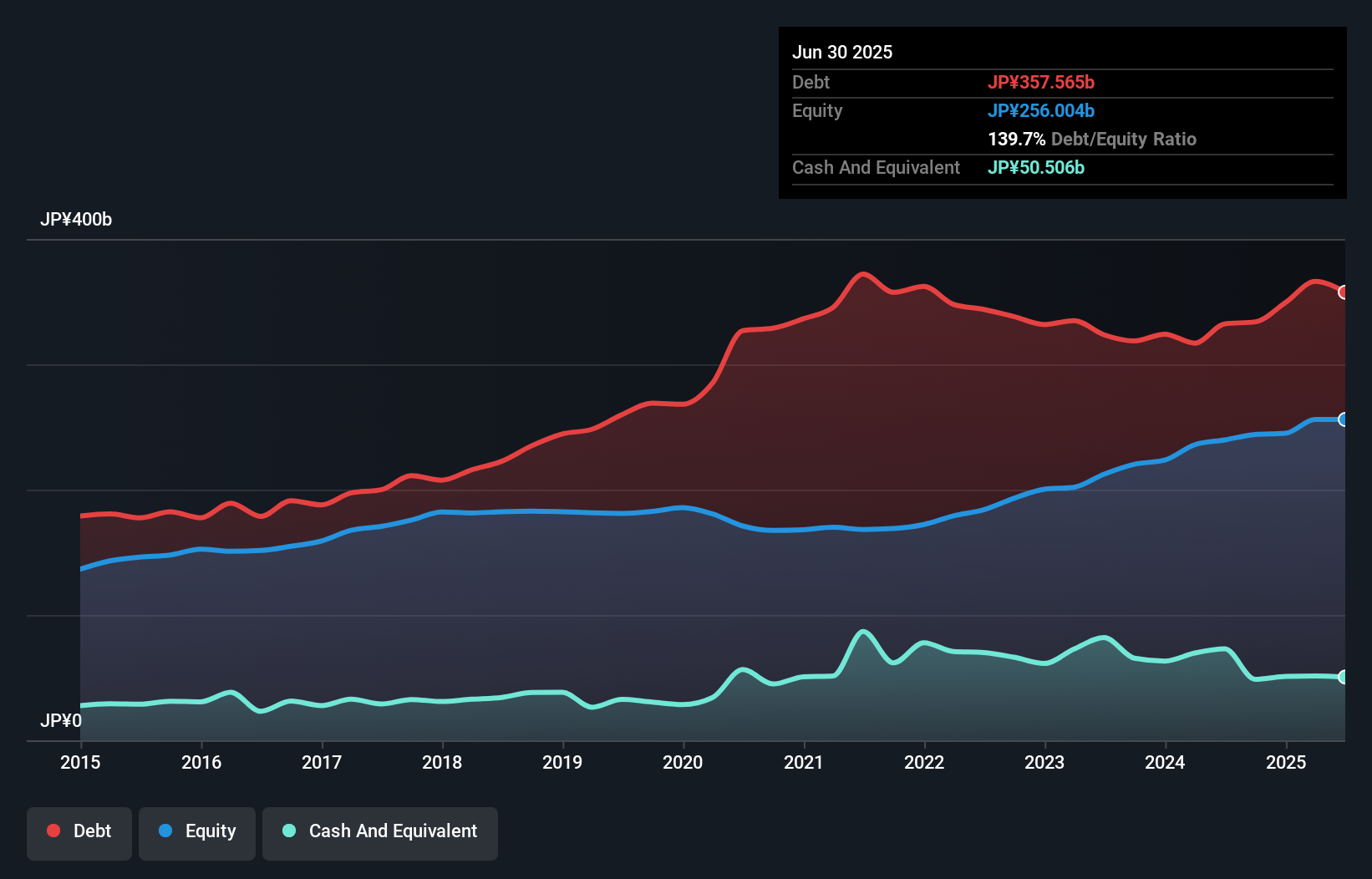The external fund manager backed by Berkshire Hathaway's Charlie Munger, Li Lu, makes no bones about it when he says 'The biggest investment risk is not the volatility of prices, but whether you will suffer a permanent loss of capital.' It's only natural to consider a company's balance sheet when you examine how risky it is, since debt is often involved when a business collapses. Importantly, Nishi-Nippon Railroad Co., Ltd. (TSE:9031) does carry debt. But is this debt a concern to shareholders?
Why Does Debt Bring Risk?
Generally speaking, debt only becomes a real problem when a company can't easily pay it off, either by raising capital or with its own cash flow. In the worst case scenario, a company can go bankrupt if it cannot pay its creditors. However, a more frequent (but still costly) occurrence is where a company must issue shares at bargain-basement prices, permanently diluting shareholders, just to shore up its balance sheet. Having said that, the most common situation is where a company manages its debt reasonably well - and to its own advantage. The first thing to do when considering how much debt a business uses is to look at its cash and debt together.
How Much Debt Does Nishi-Nippon Railroad Carry?
You can click the graphic below for the historical numbers, but it shows that as of June 2025 Nishi-Nippon Railroad had JP¥357.6b of debt, an increase on JP¥332.3b, over one year. However, it also had JP¥50.5b in cash, and so its net debt is JP¥307.1b.

A Look At Nishi-Nippon Railroad's Liabilities
The latest balance sheet data shows that Nishi-Nippon Railroad had liabilities of JP¥145.3b due within a year, and liabilities of JP¥364.5b falling due after that. On the other hand, it had cash of JP¥50.5b and JP¥50.9b worth of receivables due within a year. So its liabilities outweigh the sum of its cash and (near-term) receivables by JP¥408.5b.
This deficit casts a shadow over the JP¥179.5b company, like a colossus towering over mere mortals. So we'd watch its balance sheet closely, without a doubt. After all, Nishi-Nippon Railroad would likely require a major re-capitalisation if it had to pay its creditors today.
Check out our latest analysis for Nishi-Nippon Railroad
We measure a company's debt load relative to its earnings power by looking at its net debt divided by its earnings before interest, tax, depreciation, and amortization (EBITDA) and by calculating how easily its earnings before interest and tax (EBIT) cover its interest expense (interest cover). This way, we consider both the absolute quantum of the debt, as well as the interest rates paid on it.
Strangely Nishi-Nippon Railroad has a sky high EBITDA ratio of 6.8, implying high debt, but a strong interest coverage of 44.0. This means that unless the company has access to very cheap debt, that interest expense will likely grow in the future. Sadly, Nishi-Nippon Railroad's EBIT actually dropped 5.9% in the last year. If earnings continue on that decline then managing that debt will be difficult like delivering hot soup on a unicycle. When analysing debt levels, the balance sheet is the obvious place to start. But it is future earnings, more than anything, that will determine Nishi-Nippon Railroad's ability to maintain a healthy balance sheet going forward. So if you're focused on the future you can check out this free report showing analyst profit forecasts.
Finally, a company can only pay off debt with cold hard cash, not accounting profits. So we clearly need to look at whether that EBIT is leading to corresponding free cash flow. During the last three years, Nishi-Nippon Railroad burned a lot of cash. While that may be a result of expenditure for growth, it does make the debt far more risky.
Our View
To be frank both Nishi-Nippon Railroad's conversion of EBIT to free cash flow and its track record of staying on top of its total liabilities make us rather uncomfortable with its debt levels. But on the bright side, its interest cover is a good sign, and makes us more optimistic. Taking into account all the aforementioned factors, it looks like Nishi-Nippon Railroad has too much debt. That sort of riskiness is ok for some, but it certainly doesn't float our boat. There's no doubt that we learn most about debt from the balance sheet. However, not all investment risk resides within the balance sheet - far from it. For example, we've discovered 3 warning signs for Nishi-Nippon Railroad (2 are a bit concerning!) that you should be aware of before investing here.
At the end of the day, it's often better to focus on companies that are free from net debt. You can access our special list of such companies (all with a track record of profit growth). It's free.
Valuation is complex, but we're here to simplify it.
Discover if Nishi-Nippon Railroad might be undervalued or overvalued with our detailed analysis, featuring fair value estimates, potential risks, dividends, insider trades, and its financial condition.
Access Free AnalysisHave feedback on this article? Concerned about the content? Get in touch with us directly. Alternatively, email editorial-team (at) simplywallst.com.
This article by Simply Wall St is general in nature. We provide commentary based on historical data and analyst forecasts only using an unbiased methodology and our articles are not intended to be financial advice. It does not constitute a recommendation to buy or sell any stock, and does not take account of your objectives, or your financial situation. We aim to bring you long-term focused analysis driven by fundamental data. Note that our analysis may not factor in the latest price-sensitive company announcements or qualitative material. Simply Wall St has no position in any stocks mentioned.
About TSE:9031
Nishi-Nippon Railroad
Engages in the transportation business in Japan and internationally.
Fair value with acceptable track record.
Market Insights
Community Narratives



